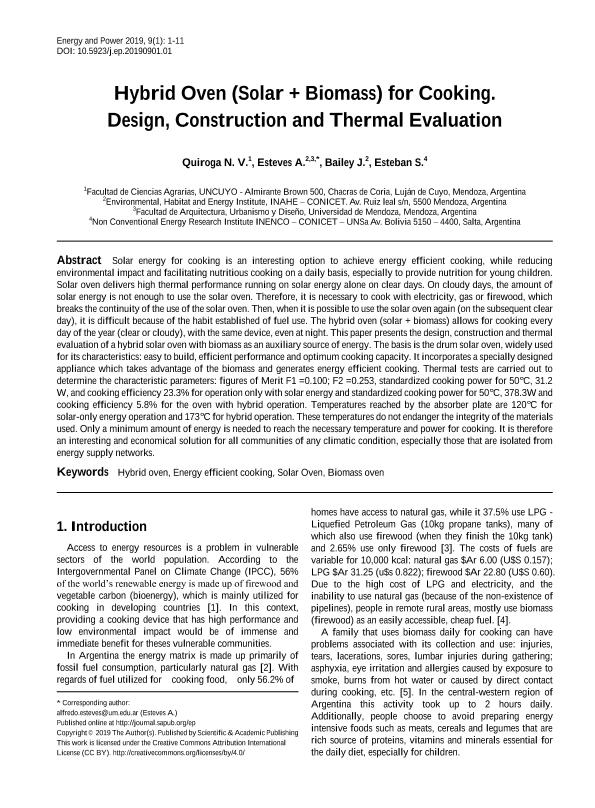Mostrar el registro sencillo del ítem
dc.contributor.author
Quiroga, Viviana Noelia

dc.contributor.author
Esteves Miramont, Alfredo

dc.contributor.author
Bailey, Jannika

dc.contributor.author
Esteban, Ester Sonia

dc.date.available
2021-01-28T02:30:24Z
dc.date.issued
2019-03
dc.identifier.citation
Quiroga, Viviana Noelia; Esteves Miramont, Alfredo; Bailey, Jannika; Esteban, Ester Sonia; Hybrid Oven (Solar + Biomass) for Cooking. Design, Construction and Thermal Evaluation; Scientific & Academic Publishing; Energy and Power; 9; 1; 3-2019; 1-11
dc.identifier.issn
2163-159X
dc.identifier.uri
http://hdl.handle.net/11336/123985
dc.description.abstract
Solar energy for cooking is an interesting option to achieve energy efficient cooking, while reducing environmental impact and facilitating nutritious cooking on a daily basis, especially to provide nutrition for young children. Solar oven delivers high thermal performance running on solar energy alone on clear days. On cloudy days, the amount of solar energy is not enough to use the solar oven. Therefore, it is necessary to cook with electricity, gas or firewood, which breaks the continuity of the use of the solar oven. Then, when it is possible to use the solar oven again (on the subsequent clear day), it is difficult because of the habit established of fuel use. The hybrid oven (solar + biomass) allows for cooking every day of the year (clear or cloudy), with the same device, even at night. This paper presents the design, construction and thermal evaluation of a hybrid solar oven with biomass as an auxiliary source of energy. The basis is the drum solar oven, widely used for its characteristics: easy to build, efficient performance and optimum cooking capacity. It incorporates a specially designed appliance which takes advantage of the biomass and generates energy efficient cooking. Thermal tests are carried out to determine the characteristic parameters: figures of Merit F1 =0.100; F2 =0.253, standardized cooking power for 50°C, 31.2 W, and cooking efficiency 23.3% for operation only with solar energy and standardized cooking power for 50°C, 378.3W and cooking efficiency 5.8% for the oven with hybrid operation. Temperatures reached by the absorber plate are 120°C for solar-only energy operation and 173°C for hybrid operation. These temperatures do not endanger the integrity of the materials used. Only a minimum amount of energy is needed to reach the necessary temperature and power for cooking. It is therefore an interesting and economical solution for all communities of any climatic condition, especially those that are isolated from energy supply networks.
dc.format
application/pdf
dc.language.iso
eng
dc.publisher
Scientific & Academic Publishing
dc.rights
info:eu-repo/semantics/openAccess
dc.rights.uri
https://creativecommons.org/licenses/by/2.5/ar/
dc.subject
HYBRID OVEN
dc.subject
ENERGY EFFICIENT COOKING
dc.subject
SOLAR OVEN
dc.subject
BIOMASS OVEN
dc.subject.classification
Otras Ingeniería del Medio Ambiente

dc.subject.classification
Ingeniería del Medio Ambiente

dc.subject.classification
INGENIERÍAS Y TECNOLOGÍAS

dc.title
Hybrid Oven (Solar + Biomass) for Cooking. Design, Construction and Thermal Evaluation
dc.type
info:eu-repo/semantics/article
dc.type
info:ar-repo/semantics/artículo
dc.type
info:eu-repo/semantics/publishedVersion
dc.date.updated
2020-11-18T16:38:46Z
dc.identifier.eissn
2163-1603
dc.journal.volume
9
dc.journal.number
1
dc.journal.pagination
1-11
dc.journal.pais
Estados Unidos

dc.journal.ciudad
California
dc.description.fil
Fil: Quiroga, Viviana Noelia. Universidad Nacional de Cuyo. Facultad de Ciencias Agrarias; Argentina. Consejo Nacional de Investigaciones Científicas y Técnicas. Centro Científico Tecnológico Conicet - Mendoza; Argentina
dc.description.fil
Fil: Esteves Miramont, Alfredo. Consejo Nacional de Investigaciones Científicas y Técnicas. Centro Científico Tecnológico Conicet - Mendoza. Instituto de Ambiente, Hábitat y Energía; Argentina. Universidad de Mendoza; Argentina
dc.description.fil
Fil: Bailey, Jannika. Consejo Nacional de Investigaciones Científicas y Técnicas. Centro Científico Tecnológico Conicet - Mendoza. Instituto de Ambiente, Hábitat y Energía; Argentina
dc.description.fil
Fil: Esteban, Ester Sonia. Consejo Nacional de Investigaciones Científicas y Técnicas. Centro Científico Tecnológico Conicet - Salta. Instituto de Investigaciones en Energía no Convencional. Universidad Nacional de Salta. Facultad de Ciencias Exactas. Departamento de Física. Instituto de Investigaciones en Energía no Convencional; Argentina
dc.journal.title
Energy and Power
dc.relation.alternativeid
info:eu-repo/semantics/altIdentifier/url/http://article.sapub.org/10.5923.j.ep.20190901.01.html
dc.relation.alternativeid
info:eu-repo/semantics/altIdentifier/doi/http://dx.doi.org/10.5923/j.ep.20190901.01
Archivos asociados
